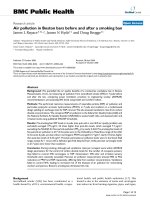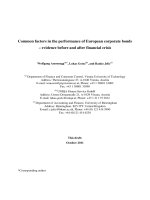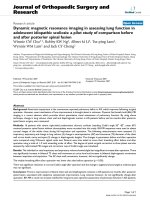Earnings management before and after CEO resignation
Bạn đang xem bản rút gọn của tài liệu. Xem và tải ngay bản đầy đủ của tài liệu tại đây (158.57 KB, 72 trang )
EARNINGS MANAGEMENT
BEFORE AND AFTER CEO RESIGNATION
ZHI QIANG
NATIONAL UNIVERSITY OF SINGAPORE
2002
- I-
EARNINGS MANAGEMENT
BEFORE AND AFTER CEO RESIGNATION
ZHI QIANG
(Bachelor of Economics, Peking University)
A THESIS SUBMITTED
FOR THE DEGREE OF MASTER OF SCIENCE IN
MANAGEMENT
DEPARTMENT OF FINANCE & ACCOUNTING
NATIONAL UNIVERSITY OF SINGAPORE
2002
- II -
Abstract
This study examines the earnings management behavior of outgoing and incoming
CEOs. The Jones Model is used to hypotheses that outgoing CEOs do not engage in
significant earnings management before resignation, and incoming CEOs manage
earnings downwards in the quarter in which they are appointed as CEO and manipulate
earnings upwards in the following quarter. The empirical evidence is consistent with
my hypotheses. My findings on outgoing CEOs are not consistent with Pourciau (1992)
and further tests suggest that the contradictory results are due mainly to the inherent
bias in Pourciau’s research methodology.
Key words: Earnings Management, Earnings Manipulation, CEO turnover, CEO
Resignation, Total Accruals, Discretionary Accruals
- III -
ACKNOWLEDGEMENTS
This academic thesis was completed with the help and support of the following people.
I am thankful to my girlfriend, who is my dearest soul mate and provide me with the
constant stream of motivation, encouragement and love. All these are the most
intangible, but nevertheless the most needed and important element to give me the
reason to keep going.
I am grateful to my family, who lend me their support and encouragement unselfishly,
and who love and care for me endlessly.
Special thanks to my supervisor, A/P Michael Shih. The completion of this thesis
could not have been possible if not for the expertise and guidance of him. I also
appreciate his consideration and patience in guiding my life in many aspects.
Last, but not least, I want to give my thanks to Mr. Lin Zhixing as well as other my
fellow classmates and friends in NUS, who brought endless pleasure and support to me.
Zhi Qiang
Dec. 2002
- IV -
TABLE OF CONTENT
ABSTRACT
III
ACKNOWLEDGEMENTS
IV
TABLE OF CONTENT
V
LIST OF TABLES AND FIGURES
VIII
CHAPTER ONE: INTRODUCTION
1
CHAPTER TWO: LITERAT URE REVIEW
5
2.1 Introduction
5
2.2 Definitions of Earnings Management
5
2.3 Motivations for Earnings Management
6
2.4 Development of Research Models
9
2.5 Earnings Management Associated with CEO Turnover
11
2.5.1 CEOs’Incentives and Methods to Manipulate Earnings
11
2.5.2 Earnings Management Associated with CEO Turnover
12
Explanations of Earnings Management Associated with CEO Turnover
12
Classification of CEO Tu rnover and Earnings Management
14
Earning Management Or Poor Performances
15
2.6 Concluding Remarks
17
-V -
CHAPTER THREE: HYPOT HESIS DEVELOPMENT
18
3.1 Limitations of Prior Research
18
3.2 Hypotheses for Ea rnings Management Before CEO Resignation
21
3.3 Hypotheses for Earnings Management After CEO Resignation
21
CHAPTER FOUR: SAMPLE SELECTION AND RESEARCH MODELS
23
4.1 Sample Selection
23
4.1.1 Timeline Surrounding CEO Resignation and Sample Selection
23
4.1.2 Descriptive Statistics for The Sample
24
4.2 Research Methodology
27
4.2.1 Total Accruals
27
4.2.2 Estimation of Discretionary Accruals
27
Estimation of Discretionary Accruals for Individual Sample Firm
27
Estimation of Discretionary Accruals by Pooled Sample
29
Testing Earnings Management by Pooled Sample on Aggregate Basis
30
Testing Earnings Management for Pooled Sample on a Quarterly Basis
31
CHAPTER FIVE: EMPIRICAL RESULTS AND DISCUSSION
32
5.1 Estimation of Discretionary Accruals by Individual Sample Firm
32
5.2 Estimation of Discretionary Accruals by Pooled Sample
37
5.2.1 Testing Earnings Management by Pooled Sample on Aggregate Basis
39
5.2.2 Testing Earnings Management by Pooled Sample on a Quarterly Basis
41
5.3 Additional Evidence
43
- VI -
5.3.1 The Healy Model
43
5.3.2 The DeAngelo Model
45
5.3.3 The Refined Jones Model
47
5.3.4 The Kang and Sivaramakrishnan Model
48
CHAPTER SIX: SUMMARY AND CONCLUSIONS
50
6.1 Summary of Findings
50
6.2 Implication of Findings
51
6.3 Contribution of Study
51
6.4 Limitations and Suggestion for Future Research
52
6.5 Conclusions
53
APPENDICES
55
- VII -
LIST OF TABLES AND FIGURES
List of Tables
Table 1 Frequency distribution of published papers exploring different motivations of
Earnings Management
7
Table 2 Selection of sample of CEO resignation, 1998-1999
24
Table 3 Descriptive statistics for the sample
25
Table 4 Mean discretionary accruals for each quarter surrounding resignation date
33
Table 5 Averages of coefficients in firm-specific regressions
35
Table 6 Estimation of discretionary accruals by pooled data
38
Table 7 Estimation of discretionary accruals by pooled data on aggregate basis
40
Table 8 Estimation of discretionary accruals by pooled data on quarterly basis
42
Table 9 The empirical results of Healy Model
44
Table 10 The empirical results for DeAngelo Model
46
List of Figures
Figure 1 Timeline surrounding CEO resignation
23
Figure 2 Mean Discretionary Accruals by individual firm
32
Figure 3 Median Unexpected Accruals using my model and Pourciau’s model
(firm-by-firm regressions)
36
Figure 4 Mean Discretionary Accruals by pooled data
38
Figure 5 Median Unexpected Accruals using my model and Pourciau’s model
(pooled data regressions)
41
Figure 6 Mean Discretionary Accruals by Refined Jones Model
48
Figure 7 Mean Discretionary Accruals by Kang and Sivaramakrishnan Model
49
- VIII -
Chapter One
Introduction
Chapter One: Introduction
There has been intense interest in the management of earnings by managers/firms,
especially after the accounting frauds committed by Enron and WorldCom were
uncovered. Academic research exploring the issue has examined the circumstances
under which managers/firms are expected to manipulate earnings and the direction of
the manipulation under each circumstance, while employing increasingly reliable
earnings management detection models.
One of the circumstances under which earnings management is expected to occur is
when there is a change in the CEO. Earnings management largely involves shifting
earnings in future periods to the current period (borrowing earnings from the future) or
deferring current earnings to future periods. Earnings management upward (downward)
in one period, therefore, eventually will be offset by earnings decreases (increases) in
the future. Thus, not every CEO has incentives to manage earnings in a particular
direction in every quarter. Departing CEOs are a special type of CEOs, however. They
are not expected to continue to hold their position long into the future, and therefore
have nothing to lose in the future if they borrow earnings from the future by
accelerating the recognition of earnings. Newly appointed CEOs may have incentives
to manage earnings in a different direction. Since they are “new kids in town”, they
probably will not be blamed for any short-term earnings weakness (“it’s the old CEO’
s
fault”). New CEOs therefore are expected to manipulate earnings downward right after
their appointment, and manipulate earnings upward later to claim credit for an earnings
turnaround.
- 1-
Chapter One
Introduction
CEO turnover can be classified either as routine (retirement) or non-routine
(resignation). This paper examines earnings management behavior before and after
non-routine CEO turnover. While many studies have investigated earnings
management associated with CEO turnover in general, very little is known about how
firms manage earnings in periods before and after a CEO resignation. The only study
that we are aware of is one by Pourciau (1992), which was published more than a
decade ago. Her test results suggest that resigning CEOs take less accounting accruals
and manage earnings downward before their departures. Pourciau herself finds the
results surprising and perplexing, and surmises that they may be attributed to resigning
CEOs having to report lower earnings in the year before their departure as a result of
their manipulating income upward (in such a subtle way to avoid detection) in the
preceding years. While that explanation is not entirely impla usible, one must question
why the outgoing CEOs are so good at manipulating earnings upward in prior years
only to suddenly lose their skill at doing so in the year preceding their resignation.
Since Pourciau’
s study was conducted a long time ago and she could not avail herself
of more sophisticated methodologies used in today’s detecting earnings management,
her surprising test results could have been explained by flaws in her test design.
Specifically, Pourciau (1992) detected earning management using the amount of total
accruals (earnings minus operating cash flow). There are several problems with such
approach: (1) failure to control for non-discretionary accruals; (2) failure to control for
poor corporate performance, which usually precedes CEO resignations; (3) failure to
control for assets write-offs/ write -downs, which are likely to be associated with poor
performance but may be not discretionary. In addition, the sample size in her study
was also relatively small.
-2 -
Chapter One
Introduction
In my study, I look for signs of earnings management in each quarter, employing a
variety of models commonly used to estimate discretionary accruals, including the
Jones model (1991) and refined Jones model. I find evidence that incoming CEOs
manipulate earnings downward in the quarter in which they are appointed and manage
earnings upward in the following quarter. Unlike Pourciau (1992), however, I find no
evidence that resigning CEOs manipulate earnings in the four-quarter period before the
date of resignation, either downward or upward. More importantly, I am able to
replicate Pouciau’s surprising results by adopting her test design for my study. This is
evidence that her results were primarily caused by flaws in her test design.
My study contributes to the literature in several ways. First, Pourciau’
s (1992) finding
that resigning CEOs manipulate earnings downward in the periods just before their
departure is puzzling. My study reexamines this issue using more sophisticated
methodology. The evidence from my study shows that these CEOs have no reasons to
manipulate earnings downward in those periods to their own detriment. My study
shows that it is very important for researchers to employ sophisticated models to detect
earning management. Second, my study also examines the earnings management of the
incoming CEO and finds that incoming CEOs manipulate earnings downward and
upward in different periods after the departure of the old CEOs. This suggests that
boards of directors should be alert to earnings manipulation in those periods.
The remainder of the study is organized as follows: Chapter two presents an overview
of the issue of earnings management and reviews the literature. Chapter three identifies
several methodological deficiencies in prior research on earnings management by
-3 -
Chapter One
Introduction
resig ning and incoming CEOs, and develops the research hypotheses. Details of the
empirical test, such as the data sources, sample selection procedure and research
methodology, are presented in Chapter four. Chapter five reports and interprets the
empirical test results. Finally, I summarize the findings of the study, discuss the
implications of the results and suggest areas for future research in Chapter six.
-4 -
Chapter Two
Literature Review
Chapter Two: Literature Review
2.1 Introduction
What is earnings management? What are the motivations for earnings management?
What are the most developed research models in this field? This part of the thesis
attempts to provide the answers.
2.2 Definitions of Earnings Management
Although much research has been done in the area of earnings management,
researchers find it is difficult to give a very clear definition of earnings management.
The followings are several definitions given in the academic literature:
“… a purposeful intervention in the external financial reporting process, with the
intent of obtaining some private gain (as opposed to, say, merely facilitating the neutral
operation of the process)…” Schipper (1989) (Page 95)
“Earnings management occurs when managers use judgment in financial reporting and
in structuring transactions to alter financial reports to either mislead some stakeholders
about the underlying economic performance of the company, or to influence
contractual outcomes that depend on reported accounting numbers.”Healy and Wahlen
(1999) (Page 104)
- 5-
Chapter Two
Literature Review
“These statements imply that within -GAAP choices can be considered to be earnings
management if they are used to “obscure” or “mask” true economic performance,
bringing us again back to managerial intent.”Dechow and Skinner (2000) (Page 67)
Although researchers have different definitions of earnings management, they are
consistent in at least two aspects. First, the objective of earnings management is to
mislead the stakeholders and to “obscure”the true economic performance of the firm.
Second, managers can get benefits from earnings management. For example, managers
can boost stock price, increase earnings-based bonus awards and avoid regulation by
means of earnings management. I will discuss these motivations of earnings
management in detail below.
2.3 Motivations for Earnings Management
The motivations for earnings management are very important to researchers in this
field. Only with a good understanding of the motivations for earnings management,
can researchers hypothesize circumstances under which managers are most likely to
manipulate accounting numbers, thus do their studies accordingly.
According to prior research, there are at least three kinds of motivations for earnings
management, including: (1) capital market motivation; (2) compensation (bonus)
motivation; and (3) anti-regulation motivation. To characterize the recent earnings
management research, a search of the academy journals in the 1993-2000 period was
conducted in The Accounting Review, Contemporary Accounting Research, Journal of
Accounting and Economics, Journal of Accounting, Auditing and Finance, Journal of
Accounting and Public Policy, Journal of Accounting Research, and Journal of
-6 -
Chapter Two
Literature Review
Business, Finance and Accounting. The search identified 47 articles examining
earnings management based on one of the three motivations. The statistics are reported
in Table 1.
Table 1: Frequency distribution of published papers exploring different
motivations of Earnings Management
Motivations for earnings management
Number of articles
%
Capital market motivation
16
34.0
Personal bonus award motivation
14
29.8
Anti-regulation motivation
17
36.2
Total
47
100.0
Notes: A search of The Accounting Review, Contemporary Accounting Research, Journal of
Accounting and Economics, Journal of Accounting, Auditing and Finance, Journal of Accounting and
Public Policy, Journal of Accounting Research, and Journal of Business, Finance and Accounting for
the period 1993-2000 was conducted. The search identified 47 articles examining earnings management
based on one of the three motivat ions.
As Table 1 shows, 34 percent of these research studies investigated the capital market
motivation for earnings management. For example, Erickson and Wang (1999)
investigated whether acquiring firms attempt to increase their stock price prior to a
stock for stock merger in order to reduce the cost of buying the target and found that
acquiring firms did manage earnings upward in the periods prior to the merger
agreement. Teoh, Wong and Rao (1998) found evidence that initial public offering
(IPO) firms, on average, have high positive issue-year earnings and abnormal accruals,
followed by poor long-run earnings and negative abnormal accruals. They believed
that the incentives to manage earnings might be especially strong when the firm is
planning to sell shares to the market. Tech, Welch and Wong (1998) provided evidence
-7 -
Chapter Two
Literature Review
that seasoned equity issuers raise reported earnings, by altering discretionary
accounting accruals, to mislead investors.
29.8 percent of these prior research studies have examined the compensation
motivation for earnings management. For instance, Holthausen, Larcker and Sloan
(1995) investigated the extent to which executives manipulate earnings to maximize
the present value of bonus plan payments and found evidence consistent with the
hypothesis that managers manipulate earnings downwards when their bonuses are at
their maximum. In addition to the earnings management by top managers, Guidry,
Leone and Rock (1999) examined bonus incentives and unexpected accruals at the
business unit level and found that earnings management is used to increase business
unit managers’earnings-based bonus awards.
Finally, 36.2 percent of previous studies focused on the anti-regulation motivation of
earnings management. Beatty, Chamberlain and Magliolo (1995) investigated how
banks altered the timing and magnitude of transactions and accruals to achieve primary
capital, tax, and earnings goals and satisfy the bank-industry regulatory constraints.
Key (1997) examined unexpected accruals for firms in the cable television industry at
the time of Congressional hearings on whether to deregulate the industry. Her evidence
is consistent with firms in the industry deferring earnings during the period of
Congressional scrutiny. Han and Wang (1998) tested whe ther oil firms that expected to
profit from the 1990 Persian Gulf Crisis used accruals to reduce their reported
quarterly earnings and, thus, political exposure. Their results are consistent with their
hypothesis.
-8 -
Chapter Two
Literature Review
2.4 Development of Research Models
Besides exploring the motivations for earnings management, another fundamental task
facing researchers is to build up a reliable model to measure management’
s discretion
over earnings and to detect earnings management. Beginning with Healy (1985), many
contemporary studies in this field have focused on accounting accruals. Accounting
accruals are the “summary measure of the timing differences that result from all
accounting choices” (Watts and Zimmerman, 1990). Total accruals, which are the
difference between net income and cash flow from operations, can be divided into the
discretionary accruals and nondiscretionary accruals. Total accruals are observable,
while discretionary accruals and nondiscretionary accruals are not. So accounting
researchers believe tha t the vital issue for testing earnings management is to find a way
to measure nondiscretionary and discretionary accruals. Three main research methods
have been developed to measure nondiscretionary and discretionary accruals. They are:
(1) aggregate accruals method; (2) specific accruals method; and (3) frequency
distribution method.
The aggregate accrual method identifies discretionary accruals based on the relation
between total accruals and hypothesized explanatory factors. For example, Healy
(1985) and DeAngelo (1986) used total accruals and change in total accruals
respectively, as measures of management’s discretion over earnings. Jones (1991)
introduced a regression approach to control for nondiscretionary accruals, specifying a
linear relation betw een total accruals and change in sales and property, plant and
equipment. According to the variables used to estimate nondiscretionary accruals, this
method can be further divided into: (1) the Healy Model; (2) the DeAngelo Model; (3)
the Jones Model; (4) the Refined Jones Model; and (5) the Kang and Sivaramakrishnan
-9 -
Chapter Two
Literature Review
Model. The Jones Model is the most frequently used model by researchers, which
suggests that the Jones Model is widely accepted as providing an adequate proxy for
earnings management.
The specific accrual method is another popular approach. It was first developed by
McNichols and Wilson (1988). Unlike the aggregate accrual method, the specific
accrual method often focuses on a certain industry in which a specific accrual or a set
of accruals can reliably reflect discretionary and nondiscretionary accruals. For
example, McNichols and Wilson (1988) used residual provision for bad debt as the
discretionary accrual proxy. They estimated the residual provision for bad debt as the
residual from a regression of the provision for bad debts on the beginning balance of
the provision, and current & future write -offs. Another example is Beaver and Engel
(1996), who used the residual allowance for loan losses as the discretionary accrual
proxy. They estimated the residual allowance for loan losses as the residual from a
regression of the allowance for loan losses on net charge -offs, loan outstanding,
nonperforming assets and one -year ahead change in nonperforming assets. Other
studies using specific accruals are Moyer (1990), Petroni (1992), Beaver and
McNichols (1998), Penalva (1998), Nelson (2000) and Petroni, Ryan and Wahlen
(1999).
The frequency distribution method was developed more recently. It assumes that
nondiscretionary accruals and reported earnings in the absence of earnings
management should be distributed evenly around a specified benchmark, such as zero,
prior quarter’
s earnings or analysts’forecast. The frequency distribution method then
examines the statistical properties of reported earnings and identifies whether
- 10 -
Chapter Two
Literature Review
discontinuities around the benchmark, which suggest the exercise of discretion, exist.
Studies using the frequency distribution method are by Burgstahler and Dichev (1997)
and Degeorge, Patel and Zeckhauser (1999).
2.5 Earnings Management Associated with CEO Turnover
2.5.1 CEOs’Incentives and Methods to Manipulate Earnings
CEOs’compensation contracts normally contain incentive provisions that link CEOs’
compensation to firms’ accounting-earnings performance. Therefore, researchers
predict that the usage of these compensation contracts will induce CEOs to engage in
earnings management to boost their salary and bonus. Prior studies have found
empirical evidences consistent with these predictions. For example, Healy, Kang and
Palepu (1987) examined the effect of accounting procedure changes on cash salary and
bonus compensation to CEOs and obtained some indirect evidence. They found the
salary and bonus payments to CEOs were dependent on reported earnings, rather than
on those “true”earnings that are “uncontaminated”.
According to prior studies, CEOs generally manipulate accounting earnings by
discretionary accruals. They normally shift earnings in future periods to the current
period (borrowing earnings from the future) or defer current earnings to future periods.
To maximize the present value of their cumulative salaries and bonuses, CEOs may
choose accounting discretionary accruals to balance the short-term and long-term
benefits. Previous studies have provided evidence consistent with this. For instance,
Holthausen, Larcker and Sloan (1995) investigated the extent to which executives
manipulate earnings to maximize the present value of bonus plan payments and found
- 11 -
Chapter Two
Literature Review
evidences consistent with the hypothesis that executives manipulate earnings
downwards when their bonuses are at their maximum.
2.5.2 Earnings Management Associated with CEO Turnover
Since CEOs generally manage earnings by moving accounting numbers from one
period to another period, researchers are very interested in how CEOs behave just
before their departing the post of CEO and just after their assuming the post of CEO.
The short horizon of CEOs’departure provides researchers a good opportunity to
examine CEOs’earning management incentives.
Explanations of Earnings Management Associated with CEO Turnover
Three main explanations of earnings management associated with CEO turnover that
have been examined in prior studies are:
(1) Horizon problem. The horizon problem suggests that outgoing CEOs approaching a
known departure date use accounting discretion to increase earnings and earningsbased compensation in their final years, at the expense of future earnings.
Since maximizing the present value of their cumulative salaries and bonuses is the goal
of the CEOs, researchers expect executives who put less value on future earnings than
current earnings to have stronger incentives to improve short -term earnings
performance. Typical executives who may place little value on future earnings are
those who are expecting to leave their positions in the near future. Therefore, CEOs are
most likely to manage earnings for short-term gains before they depart. Several
- 12 -
Chapter Two
Literature Review
previous studies have focused on earnings management associated with CEO turnover.
Dechow and Sloan (1991) investigated the hypothesis that CEOs in their final years of
office manage discretionary investment expenditures to improve short-term earnings
performance. They found evidence that CEOs spent less on R&D during their final
years in office.
(2) Cover-up. Outgoing CEOs in firms with poor performance are threatened by
termination, thus use accounting discretion to cover up the firm’s deteriorating
economic performance.
Weisbach (1988) suggested that the dominance of the board of directors by insiders
might reduce the threat of CEO dismissal associated with poor reported earnings.
Therefore, the composition of the board may influence the CEO’s incentives to
manage earnings.
(3) Big-bath. Incoming CEOs use accounting discretion to boost future earnings at the
expense of transition-year earnings by writing off unwanted operations and
unprofitable divisions.
Weisbach (1992) examined the relation between management turnover and divestitures
of recently acquired divisions. The empirical results indicated that the move to incomereducing accounting methods, the write-off of unwanted operations and the write-off
of unprofitable divisions can be attributed to incoming CEOs who implicitly blame
their predecessors for past performance.
- 13 -
Chapter Two
Literature Review
Classification of CEO Turnover and Earnings Management
While many studies have investigated earnings management associated with CEO
turnover in general, very little is known about how firms manage earnings in periods
before and after a CEO resignation. The only study that we are aware of, which
focuses on CEO resignation, is done by Pourciau (1992). It was published more than a
decade ago.
Pourciau (1992) classified CEO turnover as routine and nonroutine and examined
evidence of earnings management associated with “nonroutine” executive changes.
Her results are consistent with the hypothesis that incoming executives manage
accruals in a way that decreases earnings in the year of the executive change and
increases earnings in the following years. However, she failed to find evidence to
support her hypothesis that outgoing executives manage accruals upward before their
departure. On the contrary, her evidence indicated that outgoing CEOs manage
earnings downward. One suggested reason is that the executive had successfully
managed earnings, avoid ing termination for a number of years.
Besides Pourciau’
s paper, Murphy and Zimmerman (1993) also examined earnings
management associated with routine and nonroutine CEO turnover. However, they
found no obvious earnings management. They documented the behavior of a variety of
financial variables surrounding CEO departures and concluded that turnover-related
changes in R&D, advertising, capital expenditures, and accounting accruals are mostly
due to poor performance. They also found the managerial discretion appears to be
limited to firms whose poor performance precedes the CEO’s departure. They found
- 14 -
Chapter Two
Literature Review
no evidence of managerial discretion in strongly performing firms where the CEO
retires as part of the normal succession process.
Earning Management Or Poor Performances
Murphy and Zimmerman’s (1993) paper raised another issue regarding earnings
management associated with CEO turnover: Are the unexpected accruals documented
in prior studies indicative of CEOs’earnings management, or just the results of poor
corporate performance?
Prior researchers found CEO turnover often coincides with poor performance of firms.
For example, Weisbach (1988) and Warner et al. (1988) documented that CEO
turnover is preceded by adverse share-price and earnings performance. These studies
indicate that CEO turnover is associated with poor performance of firms.
The systematic poor performance preceding CEO changes confounds the interpretation
of tests of earnings management in two respects: (1) poor performance preceding CEO
replacement is likely to disguise attempts by the outgoing CEOs to boost earnings; and
(2) the “big bath”associated with incoming CEO may represent a correction for the
earnings boost by the former CEO or reflect a further deterioration in firm performance,
rather than opportunistic behavior of the new CEO. These possibilities make it difficult
to interpret the results as evidence of earnings management by outgoing and incoming
CEOs.
Therefore, to investigate earnings management associated with CEO turnover, one
fundamental task is to control for performance preceding CEOs’ departure. Prior
- 15 -
Chapter Two
Literature Review
researchers have acknowledged this point and tried to control for poor performance.
One well-known study that did so is Murphy and Zimmerman’s (1993).
In their paper, Murphy and Zimmerman (1993) tried to control for the poor
performance of firms in two ways:
(1) Unlike prior studies, which typically focused on a single financial variable, Murphy
and Zimmerman’s (1993) study examined eight financial variables jointly (research
and development, advertising, capital expenditures, accounting accruals, earnings,
sales, assets, and stock prices). Some of the variables (such as, R&D, advertising,
capital expenditures, and accounting accruals) were assumed to be subject to
considera ble managerial discretion, while others (such as sales, assets and stock-price
performance) were assumed to be less discretionary and to reflect largely the
performance of the firm. They then documented the behavior of these financial
variables and considered the implications of simultaneous changes among the variables.
Their findings indicate that the changes in R&D, advertising, capital expenditures, and
accounting accruals surrounding CEO turnover are due mostly to poor performance,
not management’s discretion over accruals.
(2) Contrary to the prior studies’ assumption regarding the exogeneity of CEO
turnover, this study allowed for endogenous CEO departures by using a system of
simultaneous equations. To reduce the heteroscedasticity in the simultaneous system,
ordinary least squares (OLS) and two-stage least squares (2SLS) were used. The
empirical results suggest that, after controlling for firm performance and the
endogeneity of CEO turnover, there is little evidence that CEOs use accruals to
- 16 -
Chapter Two
Literature Review
manage earnings around their departure date. In addition, the authors segmented the
sample into subsamples in which departures were unrelated to performance, and
concluded that managerial discretion is limited to performance-related CEO departures.
2.6 Concluding Remarks
In summary, prior research studies have devoted considerable efforts to earnings
management. Their research has defined the concepts of earnings management,
explored the different motivations of earnings management and developed models to
detect earnings management. Among all the available models, the Jones Model has
been the most frequently used.
Very few studies have investigated earnings management associated with CEO
turnover, and even fewer have classified CEO turnover and conducted the fur ther study.
This relative blank field give us incentives to do some research in deep.
- 17 -









